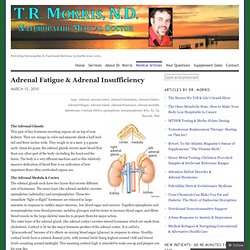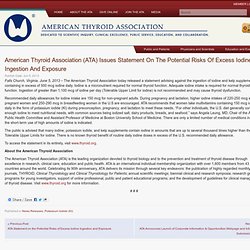

How Adrenals Can Wreak Havoc. Dr. Timothy R. (T.R.) Morris. The Adrenal Glands This pair of tiny hormone secreting organs sit on top of your kidneys.

They are orange in color and measure about a half inch tall and three inches wide. They weigh in at a mere 3-5 grams each. Gram for gram, the adrenal glands receive more blood flow than any other part of the body–including the heart and the brain. The body is a very efficient machine and so this relatively massive dedication of blood flow is an indication of how important these often overlooked organs are. The Adrenal Medula & CortexThe adrenal glands each have two layers that secrete different sets of hormones. The outer layer of the adrenal gland, (the adrenal cortex) secretes steroid hormones which are made from cholesterol. Cortisol: The Master Stress Hormone Like epinephrine and norepineprine, cortisol is also released in response to stress. Alarm ReactionAdaptationAdrenal Fatigue/insufficiencyAdrenal Failure (Addison’s Disease) The “Cortisol Steal” Phenominon Dr.
Like this: Like Loading... Hashimoto's Disease: Your Body Is Not Supposed To Attack Itself Right? Hashimoto’s thyroiditis is an autoimmune condition in which the body attacks and destroys its own thyroid gland.

Piece by piece your body chews up and destroys your own thyroid gland as if it is the enemy. In a healthy immune system, antibodies act as the body’s army to detect and destroy invaders not normally present in the body, such as bacteria, viruses, fungi, and parasites. In the case of Hashimoto’s disease, a defective immune system wreaks havoc on the body by directing antibodies against its own thyroid gland as if it is a foreign invader. Although Hashimoto’s disease is considered a leading cause of hypothyroidism around the world, it is a tragically overlooked disease in mainstream medicine. You might be thinking, “My doctor has never diagnosed me with Hashimoto’s disease. American Thyroid Association (ATA) Issues Statement On The Potential Risks Of Excess Iodine Ingestion And Exposure.
Falls Church, Virginia.

June 5, 2013 – The American Thyroid Association today released a statement advising against the ingestion of iodine and kelp supplements containing in excess of 500 mcg iodine daily. Iodine is a micronutrient required for normal thyroid function. Adequate iodine intake is required for normal thyroid function. Ingestion of greater than 1,100 mcg of iodine per day (Tolerable Upper Limit for iodine) is not recommended and may cause thyroid dysfunction. Recommended daily allowances for iodine intake are 150 mcg for non-pregnant adults. The public is advised that many iodine, potassium iodide, and kelp supplements contain iodine in amounts that are up to several thousand times higher than the daily Tolerable Upper Limits for iodine. To access the statement in its entirety, visit www.thyroid.org. A very interesting read!! at Adrenal Fatigue Support Forum, topic 2001535. This is a response to a patient given by my doctor that i think is a very interesting read.

I am currently being treated by him for hpa axis dysregulation . He is indeed an M.D. but very well versed in nutrition and natural healing as well. There is another member that is using him and seeing good results. Just thought some might be interested. The HPA axis: Metabolic Distress and Hypothalamic Amenorrhea. If it hasn’t been clear yet, the hypothalamic-pituitary-adrenal (HPA) axis is one of the leading contributors to poor reproductive health.

The pituitary gland tells the reproductive organs what to do, and the hypothalamus tells the pituitary gland what to do, and the adrenals produce cortisol which influences the activity of both the hypothalamus and the pituitary glands. Yikes. Hypothalamic amenorrhea– or the loss of menstruation via disturbance to the HPA axis–affects 5 percent of women of reproductive age. Subclinical women I suspect double that number, at least. Many problems emerge as a result of HPA axis dysregulation that do not go as far as HA. The HPA axis is dysregulated by all types of stress. Yet chronic stressors are divided by themselves into even more particular categories: psychosocial stress on one hand, and metabolic distress on the other.
This post is going to focus on metabolic distress.